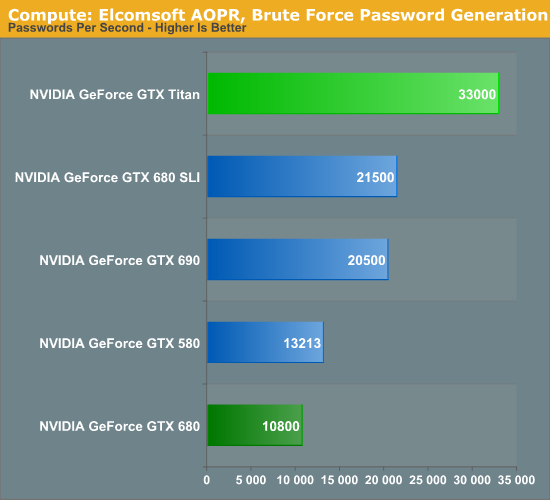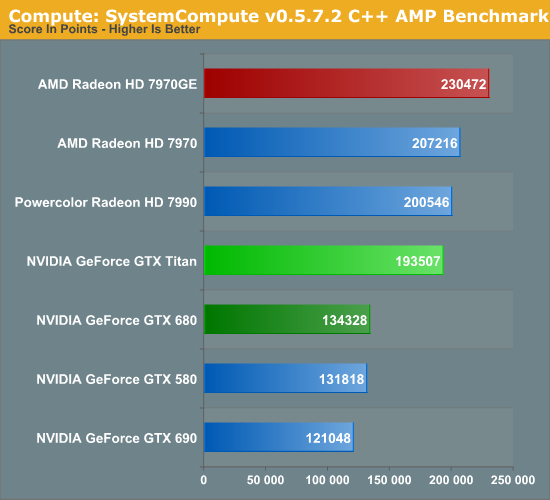NVIDIA’s GeForce GTX Titan Review, Part 2: Titan's Performance Unveiled
by Ryan Smith & Rahul Garg on February 21, 2013 9:00 AM ESTTitan’s Compute Performance, Cont
With Rahul having covered the basis of Titan’s strong compute performance, let’s shift gears a bit and take a look at real world usage.
On top of Rahul’s work with Titan, as part of our 2013 GPU benchmark suite we put together a larger number of compute benchmarks to try to cover real world usage, including the old standards of gaming usage (Civilization V) and ray tracing (LuxMark), along with several new tests. Unfortunately that got cut short when we discovered that OpenCL support is currently broken in the press drivers, which prevents us from using several of our tests. We still have our CUDA and DirectCompute benchmarks to look at, but a full look at Titan’s compute performance on our 2013 GPU benchmark suite will have to wait for another day.
For their part, NVIDIA of course already has OpenCL working on GK110 with Tesla. The issue is that somewhere between that and bringing up GK110 for Titan by integrating it into NVIDIA’s mainline GeForce drivers – specifically the new R314 branch – OpenCL support was broken. As a result we expect this will be fixed in short order, but it’s not something NVIDIA checked for ahead of the press launch of Titan, and it’s not something they could fix in time for today’s article.
Unfortunately this means that comparisons with Tahiti will be few and far between for now. Most significant cross-platform compute programs are OpenCL based rather than DirectCompute, so short of games and a couple other cases such as Ian’s C++ AMP benchmark, we don’t have too many cross-platform benchmarks to look at. With that out of the way, let’s dive into our condensed collection of compute benchmarks.
We’ll once more start with our DirectCompute game example, Civilization V, which uses DirectCompute to decompress textures on the fly. Civ V includes a sub-benchmark that exclusively tests the speed of their texture decompression algorithm by repeatedly decompressing the textures required for one of the game’s leader scenes. While DirectCompute is used in many games, this is one of the only games with a benchmark that can isolate the use of DirectCompute and its resulting performance.
Note that for 2013 we have changed the benchmark a bit, moving from using a single leader to using all of the leaders. As a result the reported numbers are higher, but they’re also not going to be comparable with this benchmark’s use from our 2012 datasets.

With Civilization V having launched in 2010, graphics cards have become significantly more powerful since then, far outpacing growth in the CPUs that feed them. As a result we’ve rather quickly drifted from being GPU bottlenecked to being CPU bottlenecked, as we see both in our Civ V game benchmarks and our DirectCompute benchmarks. For high-end GPUs the performance difference is rather minor; the gap between GTX 680 and Titan for example is 45fps, or just less than 10%. Still, it’s at least enough to get Titan past the 7970GE in this case.
Our second test is one of our new tests, utilizing Elcomsoft’s Advanced Office Password Recovery utility to take a look at GPU password generation. AOPR has separate CUDA and OpenCL kernels for NVIDIA and AMD cards respectively, which means it doesn’t follow the same code path on all GPUs but it is using an optimal path for each GPU it can handle. Unfortunately we’re having trouble getting it to recognize AMD 7900 series cards in this build, so we only have CUDA cards for the time being.

Password generation and other forms of brute force crypto is an area where the GTX 680 is particularly weak, thanks to the various compute aspects that have been stripped out in the name of efficiency. As a result it ends up below even the GTX 580 in these benchmarks, never mind AMD’s GCN cards. But with Titan/GK110 offering NVIDIA’s full compute performance, it rips through this task. In fact it more than doubles performance from both the GTX 680 and the GTX 580, indicating that the huge performance gains we’re seeing are coming from not just the additional function units, but from architectural optimizations and new instructions that improve overall efficiency and reduce the number of cycles needed to complete work on a password.
Altogether at 33K passwords/second Titan is not just faster than GTX 680, but it’s faster than GTX 690 and GTX 680 SLI, making this a test where one big GPU (and its full compute performance) is better than two smaller GPUs. It will be interesting to see where the 7970 GHz Edition and other Tahiti cards place in this test once we can get them up and running.
Our final test in our abbreviated compute benchmark suite is our very own Dr. Ian Cutress’s SystemCompute benchmark, which is a collection of several different fundamental compute algorithms. Rahul went into greater detail on this back in his look at Titan’s compute performance, but I wanted to go over it again quickly with the full lineup of cards we’ve tested.

Surprisingly, for all of its performance gains relative to GTX 680, Titan still falls notably behind the 7970GE here. Given Titan’s theoretical performance and the fundamental nature of this test we would have expected it to do better. But without additional cross-platform tests it’s hard to say whether this is something where AMD’s GCN architecture continues to shine over Kepler, or if perhaps it’s a weakness in NVIDIA’s current DirectCompute implementation for GK110. Time will tell on this one, but in the meantime this is the first solid sign that Tahiti may be more of a match for GK110 than it’s typically given credit for.










337 Comments
View All Comments
Tetracycloide - Thursday, February 21, 2013 - link
That's the thing, it's not a 'consumer gaming card.' It's a consumer compute card. Obviously the price for performance for gaming makes no sense but that's not their target market.ronin22 - Thursday, February 21, 2013 - link
This exactly!It's an amazing card for computing.
I wish I could get one...
Blazorthon - Thursday, February 21, 2013 - link
In reply to both of your comments, I have to ask this: If that is justification for its price, then why is it that AMD doesn't have their Tahiti cards priced like that and why didn't Nvidia price their previous consumer compute cards like that (GTX 280, GTX 285, GTX 480, GTX 580, etc.)?CommandoCATS - Friday, February 22, 2013 - link
Because this seems like a specialized thing for people who care about compute tasks within NVidia's CUDA universe (and things like iRay, which didn't exist when previous generations first came out).The truth is that in academia and research, CUDA is still the top dog (just do a google scholar search). I'm sure for most gamers, the GTX 680 is the way better deal. However, this is essentially a Tesla K20 for 1/3rd of the cost, so it's kind of a bargain from that perspective.
cheersloss - Saturday, February 23, 2013 - link
Exactly right. There is nothing about this card that is a value. The same compute functions were there in the older flagships as well, the gtx 580, 480, 280 etc.Titan is just an overpriced, overhyped trainwreck. Another attempt at a cashgrab on the gullible.
CeriseCogburn - Saturday, February 23, 2013 - link
The gullible that have the several thousands of extra they can spend that you don't have and cannot spend.Certainly poorboy feels better after having called his superiors gullible. The jelly is seeping through at an extraordinary rate.
cheersloss - Saturday, February 23, 2013 - link
Exactly right. There is nothing about this card that is a value. The same compute functions were there in the older flagships as well, the gtx 580, 480, 280 etc.Titan is just an overpriced, overhyped trainwreck. Another attempt at a cashgrab on the gullible.
CeriseCogburn - Saturday, February 23, 2013 - link
LOLGood you run the 280, and I'll run the Titan, and we can be equal and best friends, and I'll tell you over and over all the benchmarks and games and fps scores and compute tests are lying and your 280 is just as good and the same and you're right and I wish so badly that I was as poor as you and just bought a used 3 gen back nVidia card, but they fooled me, the gullible gamer.
CeriseCogburn - Tuesday, February 26, 2013 - link
ROFL - aww poor baby, now tessellation and compute is a total loss for amd, too as you conveniently forgot to include the 680, 670 660Ti 660 650Ti 650. hahahahha u people suck.So I can buy 2 amd cards that crash and don't run CF at all 33% of the time, or I can buy the most awesome top card in the entire world of gaming and play all the titles and be just great, or I can buy 2 nVidia cards and SLI them and have every game run except correctly except 1 while amd CF fails often...
I can buy the most stable, fully featured, many more featured nVidia card, or I can buy the dying no catalyst driver writers worth their salt (fired for savings) or left for better waters or headhunted, crashing piece of rotten unsupported glitching amd crap.
$999 looks like a bargain basement price to me. I can hardly wait to own The Shield, too.
Innovation. Awesomeness. New features. Unified drivers THAT JUST WORK.
Features ported BACKWARDS to prior generations.
Cuda
PhysX
Frame Rate Target
Boost
Stable dual card setups
Same game day drivers
Honest company not cheating liars like amd
I BUILT THIS co-founder Jen-Hsun Huang current CEO, a perfect example of the awesomeness of capitalism and personal success and the American Dream in REAL LIFE. lol
( Oh I bet those little OWS activist amd fanboys we have here are shooting blood through every pore)
Why in the world would I buy an amd card ? There's only one reason - to try to save a dying loser in a kind act of CHARITY - and frankly, what we have for amd fanboys is nothing short of the most evil little penny pinching crying whining baby SCROOGES I have ever seen.
So we can FORGET IT when it comes to the amd fanboy rabble here supporting AMD - they support only their own selfish fanboy agenda and psychotic public pocketbook panhandling.
I'd like to thank TheJian for pointing out amd fail coverage, vs the ignoring of the nVidia FINANCIAL SUCCESS STORY:
amd Q earnings coverage
"
http://www.anandtech.com/show/5465/amd-q411-fy-201...
http://www.anandtech.com/show/5764/amd-q112-earnin...
http://www.anandtech.com/show/6383/amd-q3-2012-ear...
http://www.anandtech.com/show/6690/amd-q412-and-fy...
"
nVidia Q earnings coverage
http://www.anandtech.com/show/6746/tegra-4-shipmen...
LOL - let it burn you crybabies to the CORE, I hope blood shoots from your eyes...
xaml - Sunday, March 3, 2013 - link
Don't leave out the biggest "crybaby" of all, yourself.